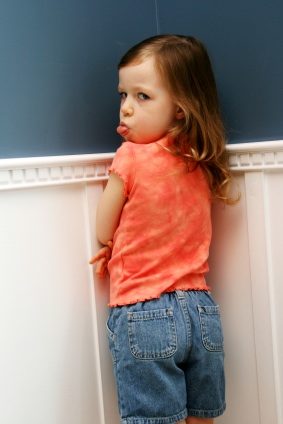
But of course, that leaves the very real question of how parents can guide a two, three or four year old, who doesn't have enough development in the prefrontal cortex yet for reason to trump emotion, and who may have no interest in following our rules!
Most experts advise parents to use Timeouts. On the surface, Timeouts seem sensible. They're non-violent but still get the child's attention. Plus, they give the parent and child a much-needed break from each other while emotions run high.
But any child can explain to you that timeouts ARE punishment, not any different than when you were made to stand in the corner as a child. And any time you punish a child, you make him feel worse about himself and you erode the parent-child relationship.
So, not surprisingly, research shows that timeouts, like other punishments, don't necessarily improve behavior. A study done by the National Institute of Mental Health[i] concluded that timeouts are effective in getting toddlers to cooperate, but only temporarily. The children misbehaved more than children who weren’t disciplined with timeouts, even when their mothers took the time to talk with them afterward. Michael Chapman and Carolyn Zahn-Wexler, the authors of the study, concluded that the children were reacting to the perceived “love withdrawal” by misbehaving more.
That’s in keeping with the studies on love withdrawal as a punishment technique, which show that kids subjected to it tend to exhibit more misbehavior, worse emotional health, and less developed morality [ii].
These results aren’t surprising, given how much children need to feel connected to us to feel safe, and how likely they are to act out when they don’t feel safe. Children act badly when they are dysregulated, and that they need to feel connected to calm down and act better. Timeouts disconnect the child from the adult, so they don't help the child to behave better.
Mona Delahooke, who writes about recent research in polyvagal science, says "Again and again, I observed children whose challenging behaviors were impervious to traditional solutions such as time-outs. Often, time-outs increased maladaptive behaviors — as well as children’s anxiety and depression...When we reframe many challenging behaviors as fight-or-flight behaviors — caused by subconscious distress — it’s easy to see that when we increase threat through the social isolation of a time-out, we are ignoring the brain-body connection. Our collective obsession about time-outs reflect an outdated perception that all behaviors are motivated and incentivized. They simply aren’t."
Alfie Kohn, in his book Unconditional Parenting,
cites numerous studies on the negative effects of timeout and other love-withdrawal techniques on children's moral and psychological development.
***
[i] Chapman, Michael and Zahn-Wexler, Carolyn. “Young Children’s Compliance and Noncompliance to Parental Discipline in a Natural Setting.” International Journal of Behavioral Development 5 (982): p. 90.
[ii] Hoffman, Martin. (1970) “Moral Development.” In Carmichael’s Manual of Child Psychology, 3rd ed., volume 2, edited by Paul H. Mussen. New York: Wiley.
So while it’s true that timeouts are infinitely better than hitting, they teach the wrong lessons, and they don’t work to create better behaved children. In fact, they tend to worsen kids' behavior. Here's why.
1. Timeouts make kids see themselves as bad people.
You confirm what she suspected – she is a bad person. Not only does this lower self esteem, it creates bad behavior, because people who feel bad about themselves behave badly.
As Otto Weininger, Ph.D. author of Time-In Parenting says:
“Sending children away to get control of their anger perpetuates the feeling of 'badness" inside them...Chances are they were already feeling not very good about themselves before the outburst and the isolation just serves to confirm in their own minds that they were right.”
2. Timeouts don't help kids learn emotional regulation.
The fastest way to teach kids to calm themselves is to provide a “holding environment” for the child, giving him the message that his out of control feelings are acceptable and can be regulated. When you send him off to his room by himself, he'll calm down eventually -- but he's no closer to learning to manage those emotions next time. That doesn't mean you need to physically hold your child when he's upset; he probably won't let you. A "holding environment" might also mean staying close and calm, saying very little, but reassuring him that he's safe and you're there with a hug when he's ready.
(Why "safe"? Because emotional dysregulation sends the child into "fight, flight or freeze" which means by definition that an upset child feels unsafe. That's why he fights you as if you're his mortal enemy instead of his beloved parent. So your goal when your child is upset is to restore safety, before you can teach appropriate behavior.)
3. Timeouts work through fear, as a symbolic abandonment.
Banishing an upset child is pushing her away just when she needs you the most. Worst of all, she only calms down and becomes more "obedient" because you've triggered the universal childhood fear of abandonment.
Dan Siegel says that the relational pain of isolation in timeout is deeply wounding to young children and that when repeated over and over, the experience of timeout can “actually change the physical structure of the brain.”
4. Timeouts don't help kids with their upsetting emotions, which makes more misbehavior likely.
Isolating the child with timeout gives her the message that you'll push her away if she expresses challenging emotions. Only her “pleasant” feelings are safe; her authentic, messy, difficult feelings – part of who we all are – are unacceptable and unlovable. A child can't separate herself from her feelings. So she concludes that she's unlovable. And she represses those difficult emotions, which just means they're no longer under conscious control and are ready to pop out with more force next time she gets upset.
5. Instead of reaffirming your relationship with your child so she WANTS to please you, timeouts fuel power struggles.
Many parents end up in physical brawls with their child while trying to drag them to timeout. The child loses face and has plenty of time to sit around fantasizing revenge. (Did you really think she was resolving to be a better person?)
6. Timeouts, like all punishment, keep us from partnering with our child to find solutions since we're making the problem all theirs.
That makes us less likely to see things from our child's perspective. It weakens our bond with our child. Unfortunately, that bond is the only reason children behave to begin with. So parents who use timeouts often find themselves in a cycle of escalating misbehavior.
What to do instead of Timeouts
In summary, timeouts, while infinitely better than hitting, are just another version of punishment by banishment and humiliation. To the degree that Timeouts are seen as punishment by kids – and they always are -- they are not as effective as positive guidance to encourage good behavior.
So if you’re using them as punishment for transgressions, that’s a signal that you need to come up with a more effective strategy. Prevention always works best, and emotion coaching is invaluable. Managing your own emotions is also essential, because that calms, rather than inflames, the storm. See How to Use Peaceful Parenting, and Handling Your Own Anger for specific strategies.
And if you’re using Timeouts to deal with your child's meltdowns, that’s actually destructive, because you’re triggering your child’s abandonment panic. Try emotion coaching and time ins.
What's Time IN?
If you want to teach your child emotional self-management, that’s only effective before a meltdown starts and the child can still access the reasoning capacity of the prefrontal cortex. When you see the warning signs, take your child to a "Time IN" to help her calm down. This signals to your child that you understand that she's got some big emotions going on and you're right there with her. If she's just a bit wound-up and wants to snuggle or even read a book, fine. If she's ready for a melt-down, you're there to help. Just let her know you're there and she's safe.
Once the meltdown starts and your child is swept with emotion, it’s too late for teaching. Don't try to talk or negotiate or convince him of anything; he's in "fight or flight" emergency mode and the thinking parts of his brain aren't working right now. Just stay nearby so you don’t trigger his abandonment panic, and stay calm. Don’t give in to whatever caused the meltdown (in other words, don't give him that cookie you said no to), but offer your total loving attention. Tell him he's safe. Be ready to reassure him of your love once he calms down.
When You're Losing It
Timeouts are a terrific management technique for keeping your own emotions regulated. But use them on yourself, not your child. When you find yourself losing it, take five. This keeps you from doing anything you’ll be sorry about later. It models wonderful self-management for your kids. And it ultimately it makes your discipline more effective because you aren’t making threats that you won’t carry out.
Parents who use timeouts are often shocked to learn that there are families who never hit, never use timeouts, and rarely raise their voices to their children. But you shouldn’t need to use these methods of discipline, and if you're using them now, you'll probably be quite relieved to hear that you can wean yourself away from them.
Check out the section on this website called How to Use Peaceful Parenting for more specifics. And remember, this too shall pass!





